Yacht-Master

A valuable tool watch
A technical and elegant watch, the Yacht-Master is a reliable nautical instrument on the wrist.
Its graduated bidirectional bezel allows for precise measurement and reading of time intervals when navigating. This tool watch benefits from innovations that improve its legibility and wearers’ comfort in all circumstances.
Graduated bidirectional bezel Precision and legibility on the wrist
The bidirectional bezel with raised 60-minute graduations is a key feature of the Yacht-Master. Entirely crafted in precious metal – 18 kt Everose gold or 950 platinum – or fitted with a black Cerachrom bezel insert in high-technology ceramic, it is an essential part of the watch’s identity.
With its polished markers and numerals, which stand out clearly from the matt surface, the bezel guarantees optimal reading of time intervals, for example, the sailing time between two buoys. Furthermore, the detailed graduation of the first 15 minutes offers extra precision when reading navigational time.
The bidirectional rotating mechanism relies on a ring bearing 120 notches for precise and fluid adjustment to the nearest half-minute. Lastly, the bezel has a knurled edge, making it easy to manipulate in all conditions.
Gold, Rolesor and Rolesium Precious alloys and exclusive combinations
Rolex gold is an intrinsic part of the Yacht-Master’s identity: 18 kt yellow, white or Everose gold are comprised of 750‰ pure gold and blends of silver, copper and palladium. They are all entirely created and cast in our own foundry.
The Yacht-Master in 18 kt Everose gold is available in two diameters: 37 mm and 40 mm. Each of these versions is also available with a diamond-paved dial. The 18 kt yellow gold and 18 kt white gold versions are reserved for the Yacht-Master 42.
Rolex gold is also combined with Oystersteel – a particularly corrosion-resistant alloy – for the Everose Rolesor versions of the Yacht-Master 37 and Yacht-Master 40. They combine a bezel and centre links in Everose gold with a middle case, winding crown, case back and outer links in Oystersteel.
The Yacht-Master 37 and the Yacht-Master 40 are also available in Rolesium versions, an alliance of platinum and steel. They combine a platinum bezel with a middle case, winding crown, case back and bracelet in Oystersteel.
RLX titanium Robustness and lightness
RLX titanium made its first appearance in the Yacht-Master range in 2023. The grade 5 titanium alloy selected by Rolex is a particularly lightweight metal and is noted for its mechanical strength and corrosion resistance. Its use for the Yacht-Master 42’s case and bracelet has reduced the weight of the watch by around a third compared to a similar watch in steel. RLX titanium is complex to work with and has required the introduction of special production processes.
The combination of polished, high-sheen and technical satin finishes illustrates our excellence in machining and finishing techniques. Together, they produce a subtle blend of textures and light, setting off the gleaming polished surface of the crown guard and the lustrous high-sheen on the top edges of the lugs against the matt of the technical satin finishing – with its pronounced grain – visible on the rest of the case and bracelet.
Bracelets, clasps and extension systems Comfort and security on the wrist
Chromalight display and cyclops lens for optimal legibility.
Equipped with the Chromalight display and the Cyclops lens, the Yacht-Master combines two exclusive Rolex features that improve legibility.
The Chromalight display provides optimum legibility, whatever the light conditions. The luminescent material is applied by experts to the hands and the large hour markers which have simple shapes (triangle, circle and rectangle) that are characteristic of Rolex professional watches. Brilliant white in daylight, this material emits an intense blue glow in the dark.
Introduced in 2008, the Chromalight display was optimized in 2021 to maintain the intensity of the blue glow for longer. The performance of this luminescent substance clearly exceeds the standards required by watchmaking norms.
Designed to improve the readability of the date thanks to its magnifying effect, the Cyclops lens is both an aesthetic and technical signature of the brand. This Rolex invention was patented in the early 1950s. Like the crystal of the watch, it is made of virtually scratchproof sapphire and benefits from a double anti-reflective coating.
Calibres 3235 and 2236 Superlative performance

Rolex Yacht-Master II (Reference 116680). A stainless steel automatic wristwatch with chronograph. 2015
International shipping available
Ships from: Georgia, United States
Taxes not included
VAT and other taxes are not reflected in the listed pricing. Read more
Authenticity guaranteed
Read more here
Description
Built for yachting, the Rolex Yacht-Master II is the most prominent mechanical timekeeper featuring a regatta chronograph. Its proprietary Ring Command System allows the bezel to work directly with the movement to set a countdown timer while on the water. The present example is a limited edition of the reference 116680, celebrating one hundred years of the Panama Canal with a special engraving on its case back. Includes Rolex box and card.
Condition Report
The watch is in overall very good condition with minor wear throughout commensurate with age. The movement is running at the time of cataloging, however, it was not tested for the accuracy of time or duration of the power reserve and may need service at the buyer's discretion. Please note that Sotheby's does not guarantee the future working of the movement.
Reference Number
Complication
Dial Color(s)
Movement Type
Case Material(s)
Case Size (mm)
Band Material
Dimension Notes
Fits a wrist size of 8 inches or smaller.
Clasp Material(s)
Conditions of Business
Please note that Condition 19 of the Buy Now Marketplace Conditions of Business for buyers doesn't apply to this item. Read more here .
0% interest for 24 months on select brands.
Your bag is currently empty.
Taxes and shipping calculated at checkout
Add a Gift Note
Adding a personal touch to your gift is easy! At checkout, enter the recipient's info in the shipping address section and we’ll include this note in the order.
Featured Brands
Case material.

1 (216) 208-6736 9am - 5pm EST M-F
Select Your Country or Region
You are currently shipping to and your order will be billed in USD $

Middle East & Africa

Asia & Oceania

Rolex Yacht-Master & Yacht-Master II: The Comprehensive Guide to the King of Sailing Watches

The Rolex Yacht-Master occupies a prominent but, for many, difficult-to-define area within the company’s overall portfolio. It’s regarded as a popular dress watch but is firmly positioned within the “Professional” collection. It looks a lot like a Submariner but isn’t really a dive watch, so it’s really not like a Submariner at all. It’s designed as a men’s watch but has become a canvas for some very feminine executions. And unlike other Rolex models that offer an original “I” and a second-generation “II” version, like the GMT-Master and Explorer, the Yacht-Master I and II are scarcely related in their design or functions at all. And yet, the Yacht-Master remains a top-tier timepiece both for Rolex and its legions of fans, and in its relatively short span on the market has welcomed a number of innovative materials and technologies into the Rolex fold. Read on to discover more about the Rolex Yacht-Master (in all its various versions) and what makes the model unique among its Oyster Perpetual brethren.
1967 - 1969 - The Prototype: Cosmograph Yacht-Master

Rolex Cosmograph Yacht-Master, circa 1967 (photo: Rolex Magazine.com )
While the Yacht-Master as we know it today traces its genesis only to 1992, the name appeared on a Rolex dial several decades before — on a watch that resembled more an evolution of the Daytona than of the Submariner — indicating that a sailing-themed watch was something that Rolex had been tinkering with as an organization for some time. In 1967, shortly after the debut of the Cosmograph (soon to be the Cosmograph Daytona) in 1963, Rolex developed a chronograph wristwatch prototype, with a three-register “reverse panda” dial and a tachymeter scale that it dubbed the “Cosmograph Yacht-Master” ( Reference 6239/6242); at 39.5mm, it was larger than the core Daytona model, which at the time was a fairly modest 36mm. Also setting it apart from all of its siblings in that collection is the odd addition of a multicolored scale at the bottom left of the 3 o’clock subdial, presumably to be used in concert with the chronograph function for counting down to the start of a yachting regatta. Only three examples of this model, which appears to have never been commercially released, are known to exist, one of them once owned by guitar legend and Rolex super-collector Eric Clapton.
1992 - Enter the “Luxury Submariner”

The first Rolex Yacht-Master in yellow gold (Ref.16628, circa 1992)
The Rolex braintrust never fully abandoned the idea of a nautically inspired boating watch to join the diving-tool Submariner (and eventually its more robust successor, the Sea-Dweller), and the Crown finally pulled the trigger on it in 1992. The Ref. 16628 model, which launched the modern Yacht-Master collection, was intended as a more luxurious version of the Submariner, at the time still regarded as more of an upscale tool watch than a dressy sport watch appropriate to be worn on the deck of a yacht. Accordingly, it looks a lot like the Submariner in its primary aesthetic and technical details. Its dial featured the same Mercedes handset; the same eclectic assortment of circles, rectangles, and triangles at the hour markers; and the same Cyclops lens-enhanced 3 o’clock date window that the Submariner acquired in 1969, along with a very similar rotating bezel with a 60-minute scale.

Rolex Yacht-Master Ref. 16628 with mother-of-pearl dial (photo: Analog:Shift )
The main differences are in the execution. For several years at that point, the case of the Submariner had been boasting a water resistance rating of 300 meters (still a standard for the model today), while the Yacht-Master’s case came in at a respectable but much more pedestrian 100 meters — again, more suited for being worn above the water than under it. While the case diameter of the newcomer was the same — 40mm — it was, along with its Oyster bracelet, made of 18k yellow gold, while the vast majority of Submariners were still made of 904L “Oystersteel.” The aforementioned bezel offers the most distinguishing differences: it rotates in both directions rather than one, another indication that the watch’s primary role was not to time dives (in which case, a unidirectional bezel that tracked how long the wearer had been underwater, and couldn’t be inadvertently moved for an inaccurate reading, was the safest option) but to be used for a more versatile array of calculations including counting down to the start of a yacht race. The more outwardly notable difference from its diving predecessor was the bezel’s 60-minute scale, which was relief-engraved directly onto the precious metal surface rather than etched into an insert made of aluminum, bakelite, or (as it is nowadays) ceramic. The overall effect was more streamlined and, objectively, more “luxury” than “tool” or “sport.” The movement inside was the same as the one the Submariner used at the time — Rolex’s “Perpetual” (i.e., automatic) Caliber 3135.
As you might surmise from the evidence at hand here, the Yacht-Master’s remarkable resemblance to the Submariner is the result of neither coincidence nor design laziness. As watch companies are apt to do occasionally, Rolex had the notion at one point, probably during the 1980s, to upgrade and revamp the look of the Submariner — which, it’s worth remembering, had not really changed much since its debut in 1953. According to industry lore, propagated by some who were involved at the time, one of those experiments yielded a watch that Rolex executives were very bullish about — but not bullish enough to actually pull the plug on the “old” Submariner design and replace it with the newer, more luxurious one, hence the revival of the 1960s “Yacht-Master” name and the launch of what would be — until the debut of the Sky-Dweller in 2012 — Rolex’s newest product family.
1994 - 2005: Growing the Fleet: Midsize, Ladies, and Two-Tone Editions

In 1994, recognizing the potential unisex appeal of its first new timepiece collection since the Daytona, Rolex followed up the original Oyster Perpetual Yacht-Master with a 35mm “Midsize” version (Ref. 68628) and an understatedly feminine 29mm “Lady Yacht-Master” model (Ref. 69628) Both were in yellow-gold, and both were powered by Rolex’s self-winding Caliber 2135, with a 42-hour power reserve. It was the first time in Rolex’s history that a model from its “Professional” series, which includes traditionally male-targeted models like the Submariner, GMT-Master, and Daytona, was offered in a smaller case size than that of the original. Even in the core 40mm sizes, the Yacht-Master template established in 1992 proved to be ideal for more decorative treatments; over the years, Rolex has released versions of the Yacht-Master 40 with ruby, sapphire, and diamond-set hour markers, mother-of-pearl dials, and even fully paved diamond-set dials.

In what would become something of a tradition for the series going forward, Rolex unveiled the first Yacht-Master with a bi-material construction in 1999. The Ref. 16622 boasted a 40mm case that combines stainless steel (for the case middle, caseback, and Oyster bracelet) and 950 platinum (for the relief-engraved bezel and the dial) in a somewhat monochromatic hybrid that the company refers to as “Rolesium.” Another bi-metal Yacht-Master iteration, one more striking in the tonal contrasts of its materials, arrived in 2005, the first “Rolesor” model, with Oystersteel and yellow gold used for the case and bracelet. That watch, Ref. 16623, was available in a variety of dial colors, including champagne, blue, and brown, and even a mother-of-pearl version.

Rolex Yacht-Master Ref. 16623 "Rolesium"
2007: Regatta Revolution: The First Yacht-Master II
In 2007, Rolex introduced the next generation of the Yacht-Master, and it was not only a significant departure from its predecessor; it was also, in a way, a return to the “Cosmograph” functionality of the 1960s prototypes. In actuality, the Yacht-Master II, first issued in a 44mm case in yellow gold (Ref. 116688) or white gold (Ref. 116689), is more appropriately described as a separate family of watches than as a branch of the main Yacht-Master series. For one thing, the movement that debuted inside the watch, Caliber 4160, was entirely new. Technically speaking, it’s a descendant of the Caliber 4130 found in Daytona models, and Rolex’s first in-house caliber to incorporate a built-in regatta countdown feature. For another, place a Yacht-Master II next to a “regular” Yacht-Master and they look, really, nothing alike. The bidirectional bezel of the Yacht-Master II is emblazoned not with the diving-inspired 60-minute scale of its smaller sibling but a countdown scale, with Arabic numerals starting with “10” and concluding at “0” spanning a semicircular arc from approximately the 8 o’clock to the 4 o’clock positions. A similar descending 10-to-0 scale is featured on the dial, positioned inside the border of the small rectangular hour markers and above the running seconds subdial at 6 o’clock. The bezel insert, made of Cerachrom, Rolex’s patented ceramic alloy, is also much more Submariner-like than Yacht-Master-like.

The first Rolex Yacht-Master II, circa 2007
The chronometer-certified movement offered not only a column-wheel driven chronograph function but an exclusive regatta countdown device, developed in-house by Rolex, that can be pre-set for intervals up to 10 minutes and whose mechanical “memory” allows it to be re-set to a previously used countdown duration. Once the watch’s countdown function is engaged, it can even be adjusted on the fly to synchronize with the precise, “official” countdown that initiates the crucial starting sequence of every regatta. While it was undeniably luxurious in its trappings — available in several precious metal options, as well as, eventually, in steel — the message delivered by the Yacht-Master II was clear: this was a watch for actual boat skippers, not just plutocrat boat owners.

Despite the niche appeal of the Yacht-Master II’s sailing-specific complication — or, perhaps because this appeal never became more widespread among Rolex fans in general — the Yacht-Master II was discontinued in 2024. Its most recent upgrades were fairly subtle: as of the all-steel Ref. 11680 introduced in 2013, the movement inside shifted to Caliber 4161, which (according to Rolex) improved upon the 4160’s reliability and the user-friendliness of its pushers.
2015: Everose Meets Oysterflex

Even before the decision to retire the Yacht-Master II from the lineup, throughout the past decade it has been the original, core Yacht-Master model, the one without the regatta timer, that has received the most attention from the brand, with more firsts for the model arriving in 2015. The Ref. 116655, launched at that year’s Baselworld watch fair, was the first Yacht-Master with a case made from Rolex’s proprietary rose-gold alloy called Everose gold, and the first to contain a movement meeting Rolex’s “Superlative Chronometer” standard that was rolled out the same year. Its bezel was executed in black Cerachrom, albeit with the same relief-style scale as its metal predecessors rather than the etched scale of the Submariner. What many remember best is that it was also the first watch to be mounted on Rolex’s innovative Oysterflex bracelet — which on its exterior resembles a fairly traditional black rubber strap but on its interior is equipped with a patented “longitudinal cushion” system, made up of nickel-titanium blades inside an elastomer coating. The patented design gives an Oysterflex the suppleness and comfort of a strap while still providing the robustness and stability of a bracelet, and this style of wristlet has been a mainstay within Rolex’s “Professional” series of watches ever since, though still most closely associated with the Yacht-Master. Somewhat more quietly in that same year of big Yacht-Master moves, Rolex discontinued the 35mm Midsize and 29mm Ladies models, replacing them with a new series of arguably more “unisex” 37mm Yacht-Masters; today, this represents the smallest option within the collection.
2019: A Bigger Boat with a Better Engine: Introducing the Yacht-Master 42

The core Yacht-Master collection welcomed a new size and a new movement in 2019. For the first time since the debut of the 40mm original, the case size was increased, to 42mm, in the white-gold-cased Ref. 226659. It was, somewhat surprisingly for a watch that had undergone so many luxurious iterations in its history, the first time that particular precious metal had been employed for a Yacht-Master case. The watch’s Cerachrom bezel insert was in matte-black, to match the dial, and featured the same relief-raised scale and numerals as its 40mm siblings. The Yacht-Master 42 also marked the first use of the “Superlative Chronometer” Caliber 3235 in the Yacht-Master family.

Rolex Caliber 3235
In production since 2015, Caliber 3235 is one of Rolex’s most optimized in-house calibers and has been gradually replacing the venerable 3135 in many of the brand’s three-hand-date models, from the basic Datejust to the Submariner, Sea-Dweller, and Yacht-Master. The movement’s host of talking points includes the patented “Chronergy” escapement, made of magnetism-resistant nickel phosphorus that renders the movement both highly energy efficient and extremely durable; the Rolex-exclusive blued Parachrom hairspring that gives the oscillator a greater level of resistance to magnetism and shocks; and the lengthy 72-hour power reserve and industry-leading “Superlative Chronometer” accuracy to +/- 2 seconds per day.
2023: Sailing to the Future in Titanium

Rolex is famously of the “slow and steady wins the race” philosophy when it comes to adopting new materials and buying into industry trends in general. The brand waited until 2022 to make its first watch case in titanium (specifically grade 5 titanium, which Rolex — of course — calls by its own in-house moniker of RLX Titanium) — and that watch, the 50mm, 36,000-meter water resistant Deepsea Challenge, was anything but an everyday timepiece. One year later, it was a Yacht-Master, in the recently established 42mm case size, that ushered RLX titanium into more wearable territory. RLX titanium is a strong, corrosion-resistant and very lightweight alloy, with a technical satin finish lending it a sleek, subtly grainy texture. The watch’s case is milled from a single block of the material and is enhanced with shiny polished facets that help to frame and elegantly define its broader satin-finished surfaces. The black dial — Rolex calls it “intense black” and who am I to disagree? — has its own grained texture, and the titanium bracelet is fitted with ceramic inserts and equipped with the brand’s Easylink extension system for maximum wearing comfort. Inside beats the reliable and increasingly ubiquitous Rolex Superlative Chronometer Caliber 3235.
In a way, the latest model finally brings the Yacht-Master from its “luxury Submariner” origins to what many feel is its proper tool-watch identity. It will be intriguing to see if future versions of the Yacht-Master — now that the original model stands alone, without its chronograph-countdown sibling, as the Rolex watch for sailors and other seaborne sojourners — venture more into the placid waves of dress-watch elegance or the churning whitewater of regatta-race utility. Knowing Rolex, it’s likely to be the most crowd-pleasing combination of both.
Start the Conversation

Get your watch from TeddyBaldassarre.com and get 0% interest for up to 24 months available on select brands . Checkout with Affirm and spread your payments over 3 to 36 months. Learn More
Recommended Articles

The Best Rolex Watches for Collectors and the Stories Behind Them

Rolex Submariner: The Ultimate Guide to the World’s Leading Luxury Dive Watch

15 Best Sailing Watches in 2023, from Affordable to Luxury
Featured collection.
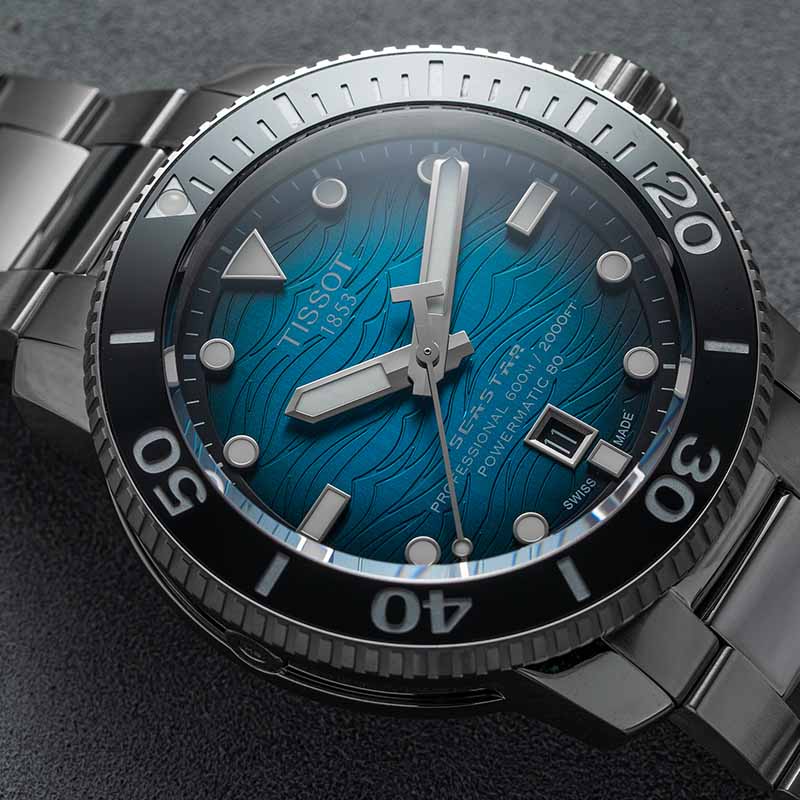
Shop Our Best Dive Watches Under $2,500
Authorized Retailer
Official Authorized Dealer of over 40+ leading luxury brands.
Customer Support
Dedicated customer service staff ready to resolve any purchase or product issues.

Shipping + Fulfillment
Swift delivery directly from our fulfillment center, no product sourcing or un-stocked consignment.

Curated Collection
We work with leading luxury brands to provide the best selection for discerning collectors.
We just redirected you to the best site experience based on your location. If you still want to go to the previous country, you can select it in the international menu.
This site uses cookies to provide you with a great user experience. By using TeddyBaldassarre.com, you accept our use of cookies.
Join Our Newsletter
Blog, Watch News and Reviews
Latest Watch Releases and Offers in the Shop
Check your inbox and be on the look-out.
- Create Account
- Check Order Status
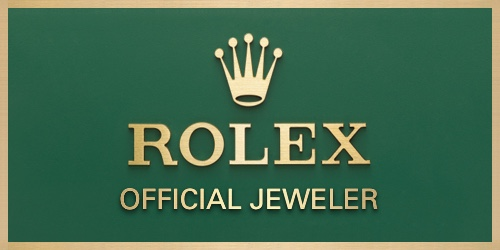
Rolex Yacht-Master 42 Oyster, 42 mm, RLX titanium M226627-0001

All Rolex watches are assembled by hand with the utmost care to ensure exceptional quality. Such high standards naturally restrict Rolex production capacity and, at times, the demand for Rolex watches outpaces this capacity.
Therefore, the availability of certain models may be limited. New Rolex watches are exclusively sold by Official Rolex Jewelers, who receive regular deliveries and independently manage the allocation and sales of watches to customers.
Ben Bridge is proud to be part of the worldwide network of Official Rolex Jewelers and can provide information on the availability of Rolex watches.

Send a message
Please enter your message
Thank you for your interest in Rolex watches. Please enter your message below and we will be delighted to assist you.
Please enter your contact information

Discover Rolex

Rolex watches

New watches 2024
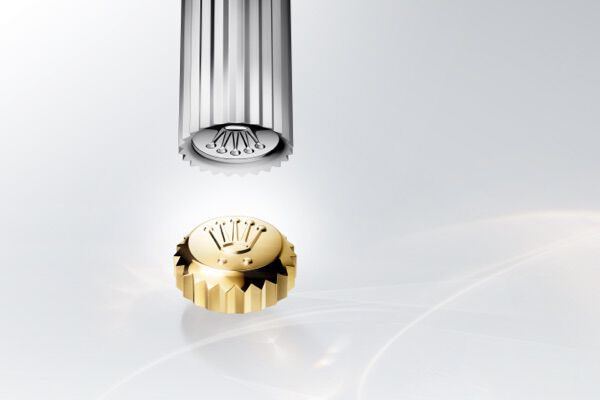
Watchmaking

World of Rolex

Your message has been sent. We will contact you shortly.
Added to Manage List
Removed from Undo
List Updated Manage List
Recently Searched
Rolex yacht-master 116655 ultimate buying guide.

Rolex’s Yacht-Master series emerged in the early nineties, touted as a nautically-themed luxury lifestyle offering against the all-out professional tools of the brand’s dive trio.
Although quite clearly cut from the same mold as the Submariner (and there were even rumors it was originally dreamt up back in the eighties as a possible replacement for the legendary Sub), it has always set itself apart with its softer, more graceful lines and choice of materials. The closest you’ll find to the utility of steel here is when it’s being gentrified by the presence of Rolex’s own 18K gold in their Rolesor models or their platinum in the Rolesium versions – a combination that made its debut with the first wave of these Rolex Yachtmaster watches for sale .
Precious metals don’t come cheap, and the YM has consequently not had the same universal mass appeal as others in the Oyster Professional range. It has always purposely avoided going too sporty, aiming the model at a more targeted audience – those who, for example, may own luxury yachts.
Let’s take a look at one of Rolex’s most interesting and beautifully balanced masterpieces, the Yacht-Master in Everose.
What You Need to Know About the Everose Yacht-Master 40 Ref. 116655
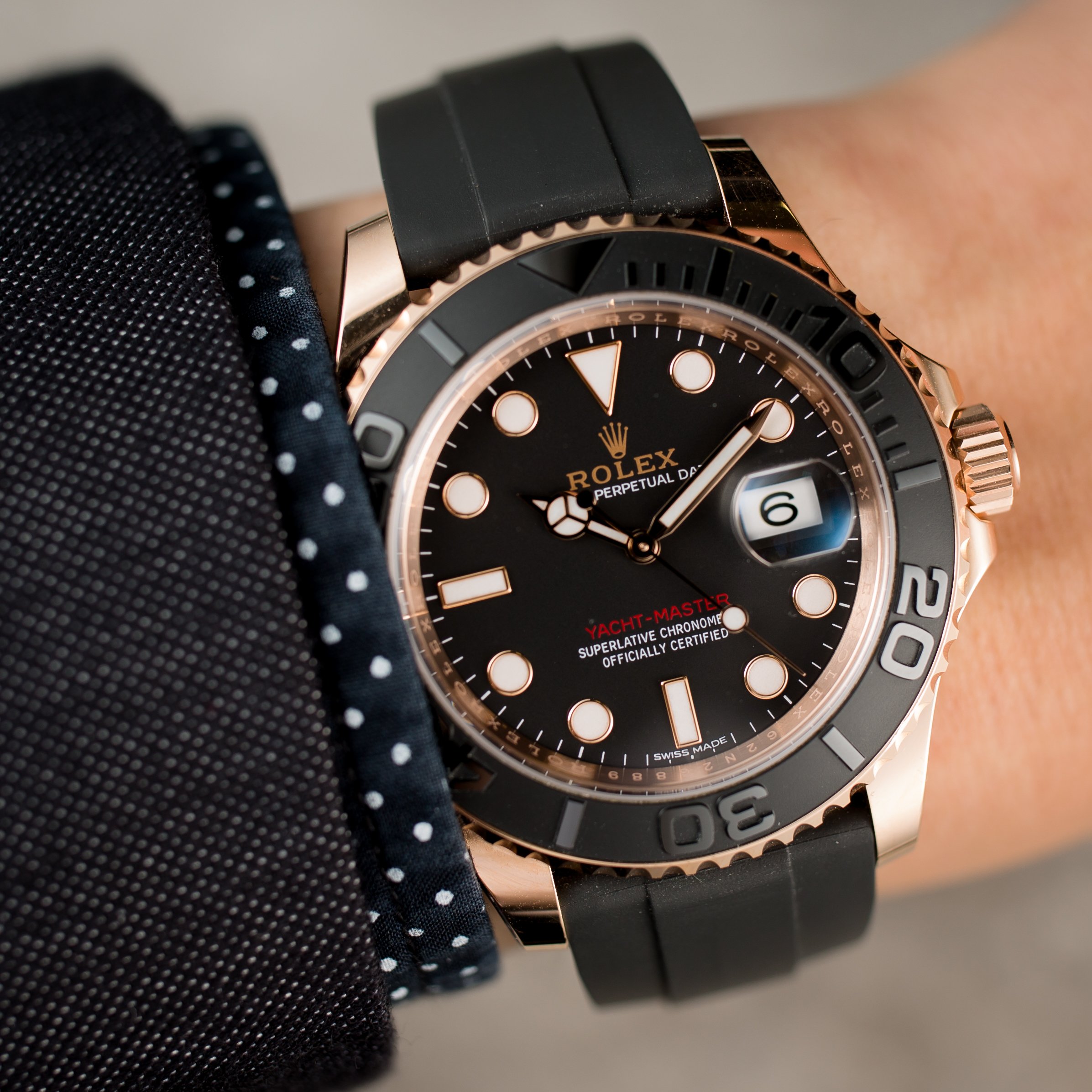
Yacht-Master 116655 Key Features
Case: 40mm Material: Everose – 18k Rose Gold Bezel: Bi-Directional, Cerachrom Movement: Automatic cal. 3135 Functions: Date Dial: Black w/ Chromalight Bracelet: Oysterflex Water Resistance: 100 Meters/330 feet
Yacht-Master 116655: One of A Kind
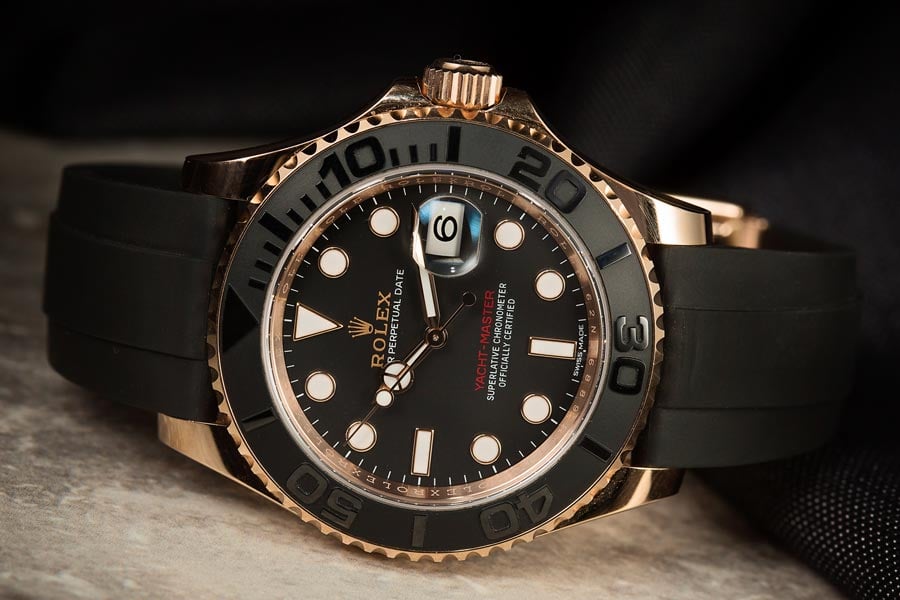
In 2015, a new Yachtmaster with many surprises up its sleeve made its grand entrance. The Yacht-Master reference 116655 brought with it several firsts, not just for the Yacht-Master range, but for Rolex itself. It was the first Rolex for sale to feature the innovative Oysterflex bracelet, the brand’s take on the rubber strap. It was also the first Yacht-Master to ditch the precious metal bezel for Cerachrom, Rolex’s term for ceramic. Of course, the bezel is produced in matte black to match the sleek Oysterflex strap.
The Rolex Yacht-Master Rose Gold 40mm
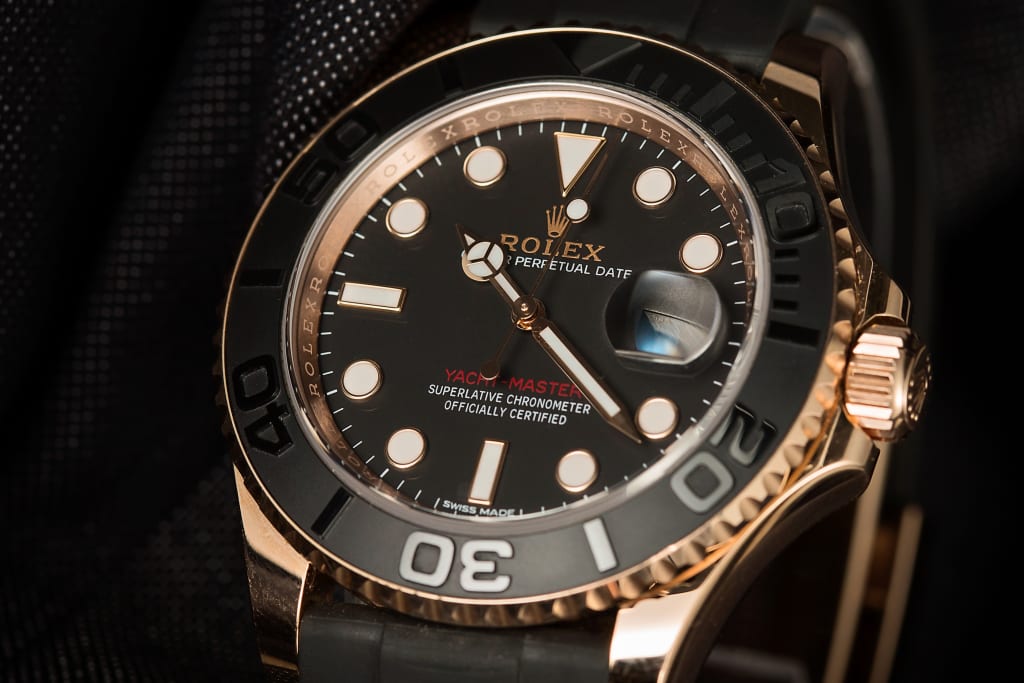
While their bezels have always featured embossed numerals, as opposed to the engraved ones favored by the rest of the brand’s catalog, the contrast between the high polish of the three-dimensional markings against that gloriously muted, sandblasted ceramic gives an altogether more dramatic effect. This design is echoed on the black dial, replacing what is typically a glossy element on other similarly colored Rolex watches for a matte hue to match the bezel and bracelet.
Juxtaposing against the high-polish and elegantly curved 18k Everose case, Rolex’s own blend of gold and copper with a dash of platinum to seal it all in, it underlines the ref. 116655’s status as the best of both worlds. Dressy enough for the yacht club; sporty enough for the yacht race.
The Oysterflex Bracelet
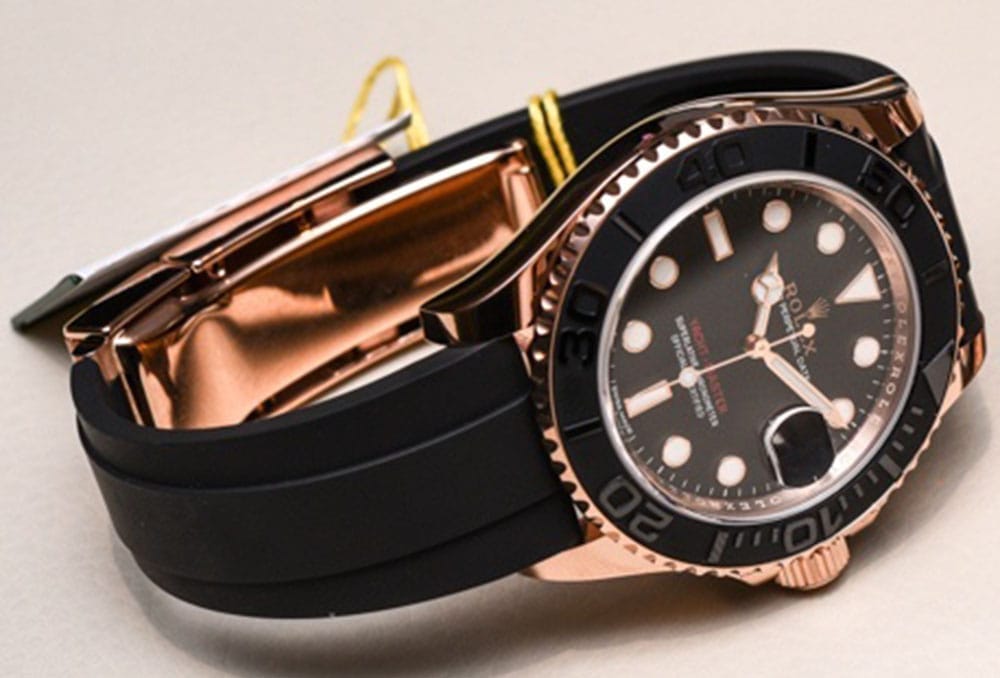
At the core of the Oysterflex is a blade forged from an alloy of titanium and nickel, molded in a high-performance, hypoallergenic elastomer. It means, not only is the bracelet exceptionally resistant to environmental rigors, but it’s also free to form itself to the shape of the wearer’s wrist while retaining all the strength of any of the brand’s metal bands.
It is an extremely comfortable bracelet, made even more so by the addition of a pair of ‘fins’ underneath that both cushion and support the watch while also providing airflow to cool the wrist on warm days. The bracelet is secured by the same Oysterlock clasp as you’ll find on most Rolex sports models and comes with the 5mm Easylink extension system for a spot of fine-tuning.
The only drawback compared to, say, the traditional Oyster bracelet is obviously in making larger adjustments. There are no links to add or remove, and, unlike other rubber straps, cutting it to size isn’t an option, thanks to the metal core. Rolex offers a choice of bracelet size at the time of purchase, but it does mean you won’t be able to lend your watch to anyone with significantly bigger or smaller wrists than you. Oh well!
The Calibre 3135 Perpetual Movement
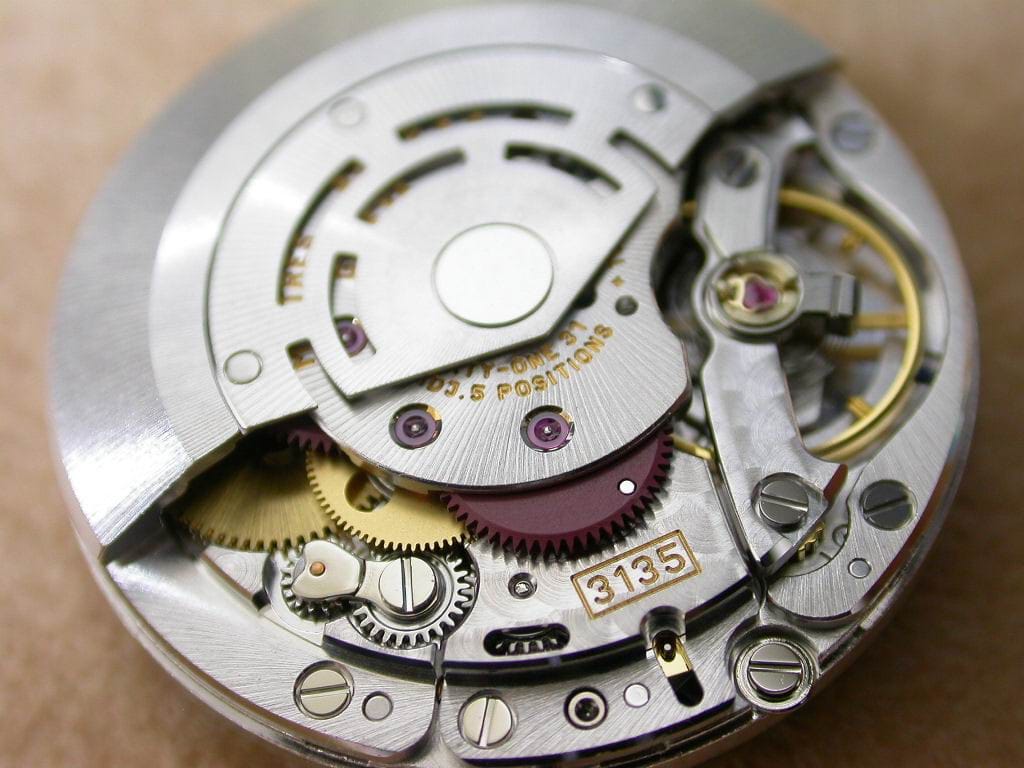
Inside the 40mm ref. 116655 is the battle-hardened and utterly reliable Cal. 3135, which remained Rolex’s main engine from 1988 until just recently when it was replaced by its successor – calibre 3235. Performing way beyond the standards set down by the COSC, it’s accurate to within +2/-2 seconds a day. Cal. 3135 also boasts a Paramagnetic blue Parachrom hairspring and a convenient 48-hour power reserve. Even if you set your Rolex Yachtmaster down and don’t pick it up until a day or so later, it will continue to read true.
The Next Generation of Yacht Masters: The Rolex 116655 vs. 126655
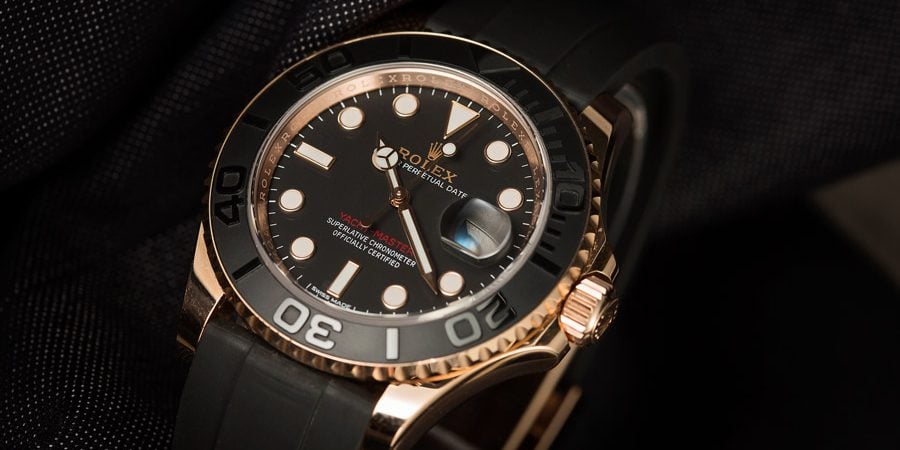
In 2019, a new collection of regatta timers came to market, replacing the first 6-digit 1166XX generation. The beloved cal. 3135 retired from the Yacht-Master collection altogether, making way for the new and improved calibre 3235 with a more efficient skeletonized Chronergy escapement and, thus, a longer 70-hour power reserve. The Everose and Oysterflex Yacht-Master survived the transition, housing the improved movement within the current ref. 126655. It features a similar design set as ref. 116655, including a 40mm case and the same stunning matte black ceramic bezel. Also joining the new 40mm lineup were Rolesium ref. 126622 and Everose Rolesor ref. 126621.
Future Classic?
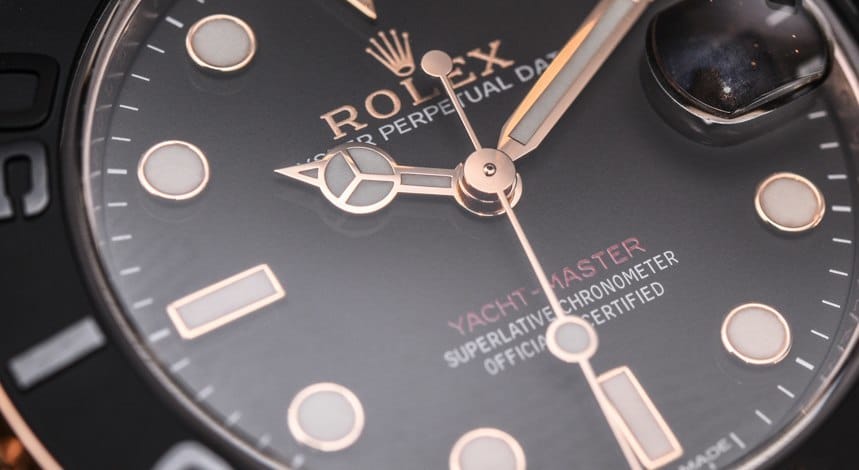
The Yacht-Master ref. 116655 has all the hallmarks of a classic in the making. It’s a radical departure from the norm, and it debuted several never-before-seen features. Additionally, Its matte dial with the red text gives it a healthy vintage feel, and its hefty retail price will grant it an invaluable degree of exclusivity.
If we were gamblers, we certainly wouldn’t bet against it becoming a highly sought-after piece in years to come, but that isn’t the best reason to add one to your collection if the budget allows. This is simply one of the most strikingly good-looking and capable watches ever produced by a brand that sets the standard other manufacturers try to live up to. A model welcomed anywhere, whether on deck or on the beach, the Everose gold Yacht-Master 40 is Rolex at their formidable best.
About Paul Altieri
Paul Altieri is a vintage and pre-owned Rolex specialist, entrepreneur, and the founder and CEO of BobsWatches.com. - the largest and most trusted name in luxury watches. He is widely considered a pioneer in the industry for bringing transparency and innovation to a once-considered stagnant industry. His experience spans over 35 years and he has been published in numerous publications including Forbes, The NY Times, WatchPro, and Fortune Magazine. Paul is committed to staying up-to-date with the latest research and developments in the watch industry and e-commerce, and regularly engages with other professionals in the industry. He is a member of the IWJG, the AWCI and a graduate of the GIA. Alongside running the premier retailer of pre-owned Rolex watches, Paul is a prominent Rolex watch collector himself amassing one of the largest private collections of rare timepieces. In an interview with the WSJ lifestyle/fashion editor Christina Binkley, Paul opened his vault to display his extensive collection of vintage Rolex Submariners and Daytonas. Paul Altieri is a trusted and recognized authority in the watch industry with a proven track record of expertise, professionalism, and commitment to excellence.

Bob's Watches Blog Updates
Sign up and be the first to read exclusive articles and the latest horological news.
Bob's Watches / Rolex Blog / Rolex News
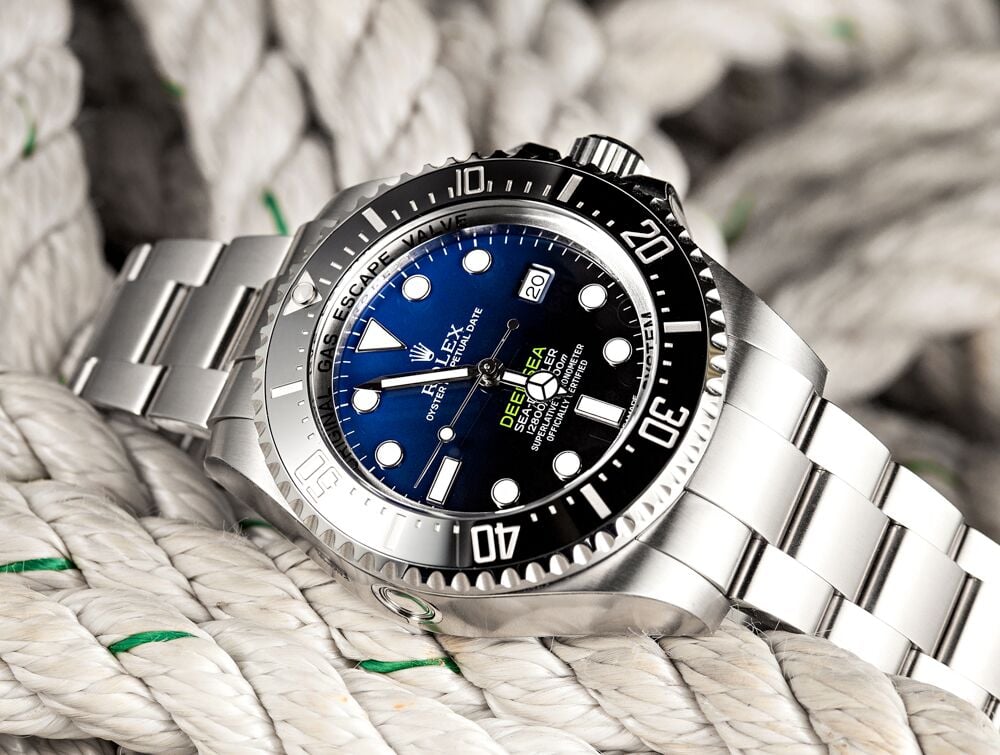
Recommended Articles

Rolex 126710 GMT-Master II Ultimate Buying Guide

Rolex Oyster Perpetual Dial Colors – The Ultimate Guide

Jon Rahm: Rolex Watch Ambassador Crowned The U.S. Open 2021 Winner
You may also like.

Rolex Daytona
Rolex Daytona 116500 Ceramic Bezel

Tudor Black Bay
Tudor Black Bay Chrono 79360N

Patek Philippe Complications
Patek Philippe Complications Rose Gold Olive Green Dial
Hands-on with the Rolex Yacht-Master 116655 (Everose gold on Rubber Strap) – Live Photos & Price
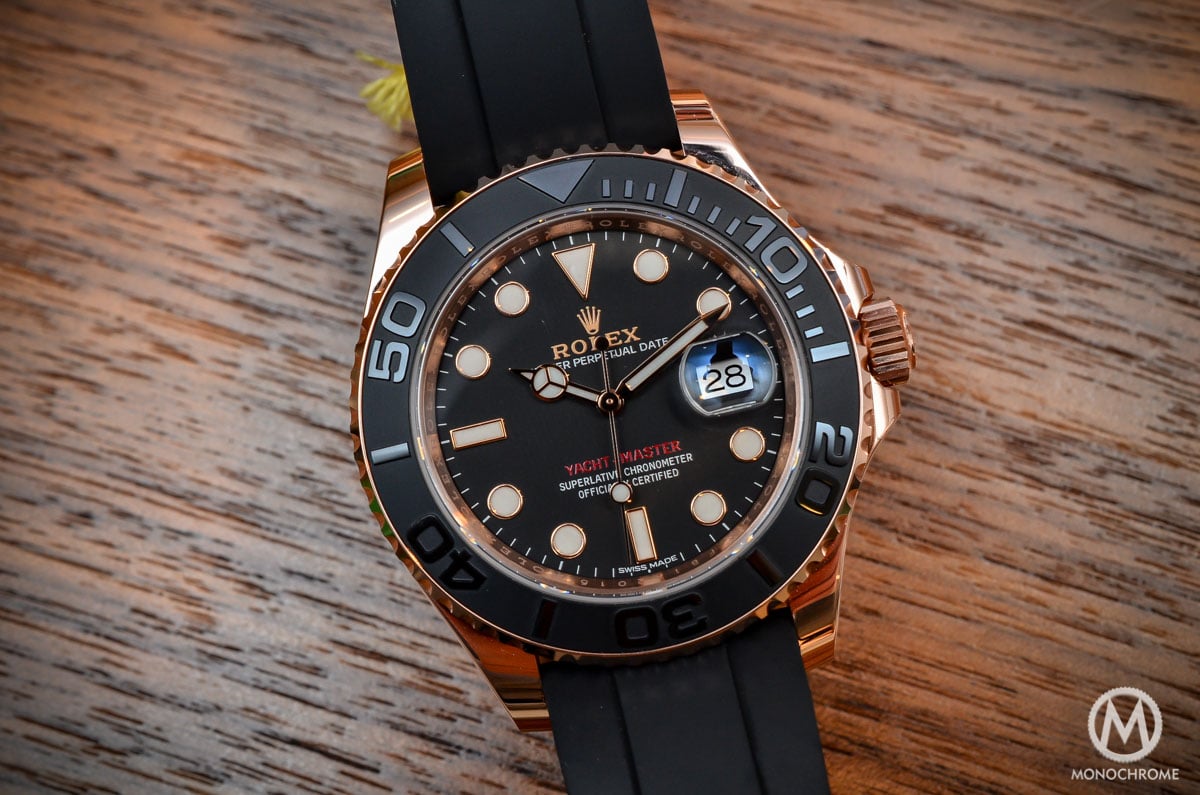
Rolex may have a new CEO , it’s not meaning that things are going to radically change for the old house. The ‘Crown’ is known for just updating and improving the collections instead of entirely changing them. For Baselworld 2015, you won’t be surprised to see that the recipe had been kept. However, one of the classics is receiving an important update. Here is the new edition of the Rolex Yacht-Master now in Everose gold, with a ceramic bezel and with a rubber strap.
The Rolex Yacht-Master was one of the few Rolexes that wasn’t updated. The rest of the collection – Submariner , Explorer II, Milgauss or Sea-Dweller – had received, at least, a small update or a more important change. However, all of them are keeping the same base and weren’t a totall renewal of the existing models. The recipe for this new Rolex Yacht-Master 116655 is exactly the same: keeping the same bases and adding the new technologies – and another important (at least for Rolex) novelty.
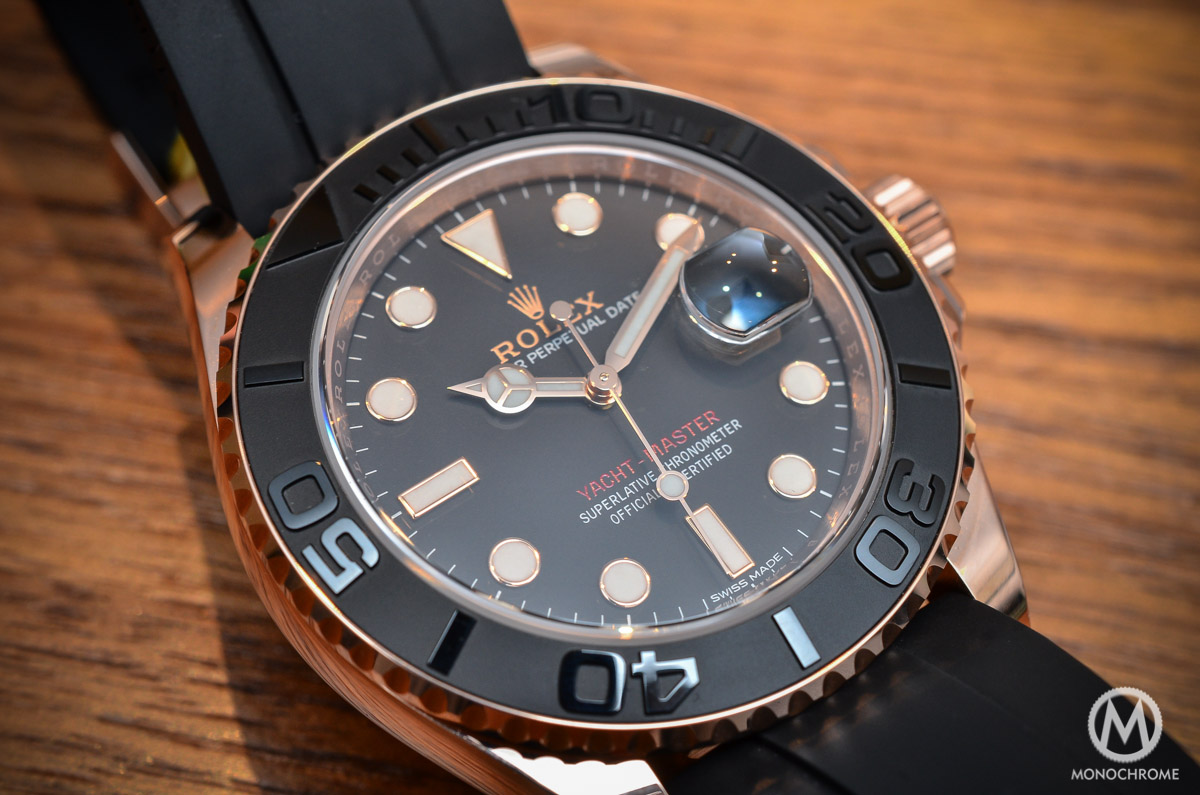
The first thing that had been updated on this Rolex Yacht-Master 116655 is the 40mm case, that now comes in 18K rose gold (or Everose as Rolex likes to call its own alloy). Previously available only in stainless steel (with a platinum bezel) with both a silver or a blue dial, the Rolex Yacht-Master now turns to precious metal. The case however is not totally the same than in the stainless editions. The case bands are slimmer and the lugs are more curved, to better fit the wrist. Of course, the typically Rolex fluted caseback is still here and is also executed in 18k rose gold. Water resistance is still at 100m.
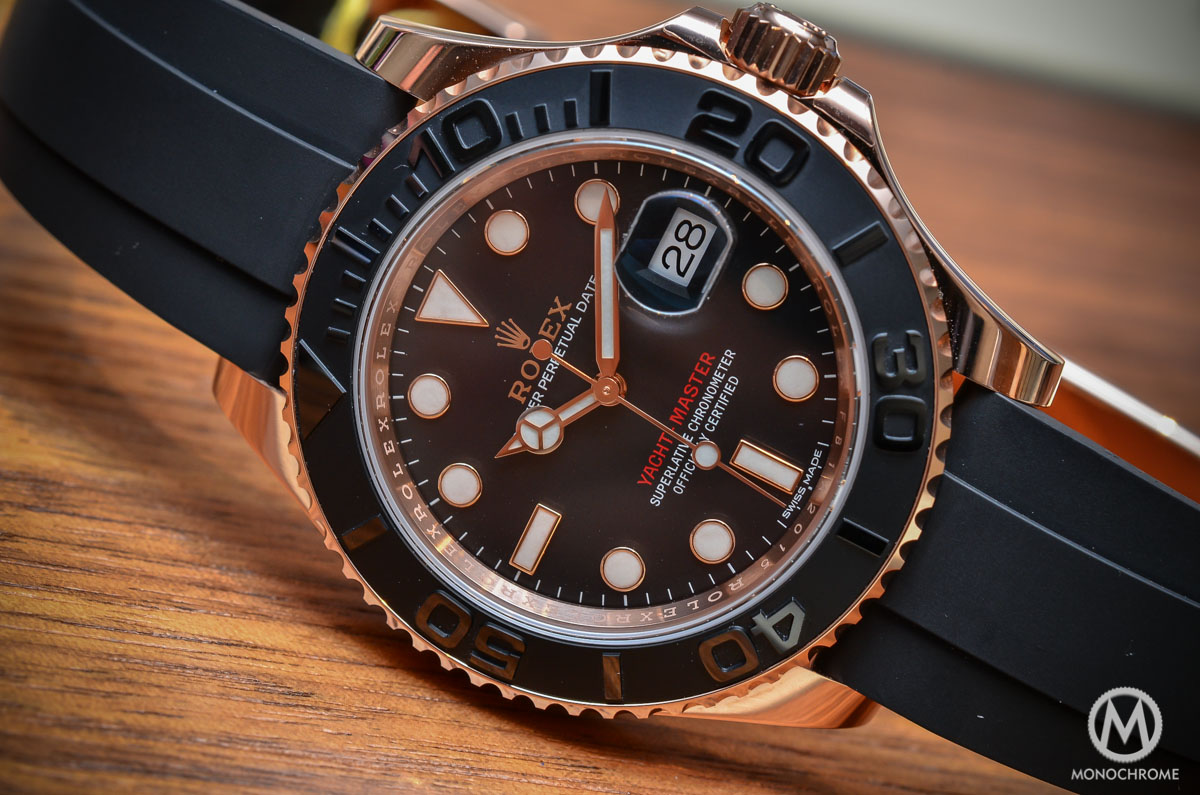
The face of the watch is also updated with new materials and colors. As you’ve probably noticed, the bezel keeps its raised numerals and its 60-minute scale but it now comes in black Cerachrom (Rolex own ceramic), with numbers and graduations polished on the top while the background remains matt, in order to allow a good contrast. The dial also shares this same deep black color and comes with gold applied indexes filled with white luminous material. The rest, from the crystal (with no antireflective coating), to the cyclops or the Mercedes hands, remains the same as the stainless steel edition. The same goes for the movement as the Rolex Yacht-Master 116655 still sports the calibre 3135, a robust, in-house automatic movement with date and chronometer rated (by COSC).
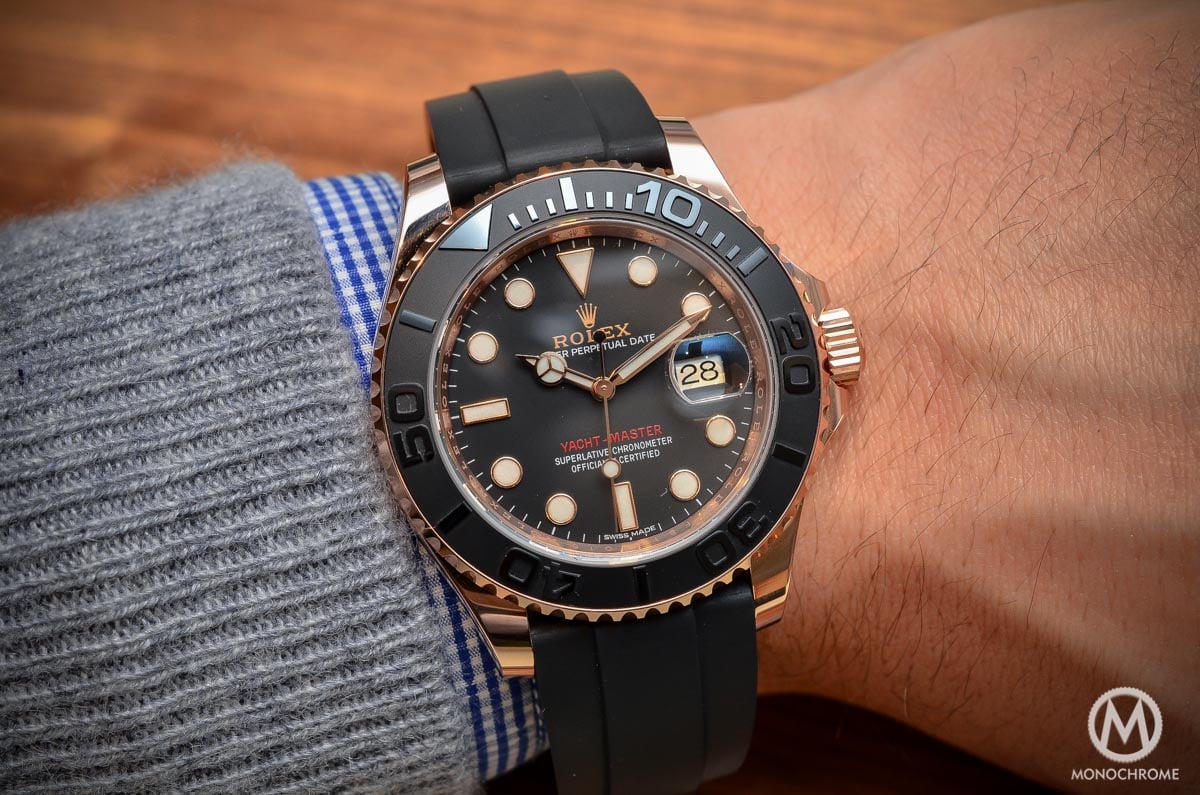
The big novelty is however in the strap. For the first time, Rolex comes with a Rubber strap. That might be something quite random for most of the brands but for Rolex collectors, this is big. This black Oysterflex bracelet is made in a very soft and flexible rubber. Due to longitudinal cushion system that stabilizes the watch (two very soft rubber bands on the internal part of the strap), it feels extremely comfortable on the wrist, making the Rolex Yacht-Master 116655 a real pleasure on the wrist. This Oysterflex bracelet is fitted on an 18k Everose gold Oysterlock clasp.
However, don’t imagine having this strap on another of your Rolex, as the attachment is specific to this new edition of the Yacht-Master and won’t fit any other watch.
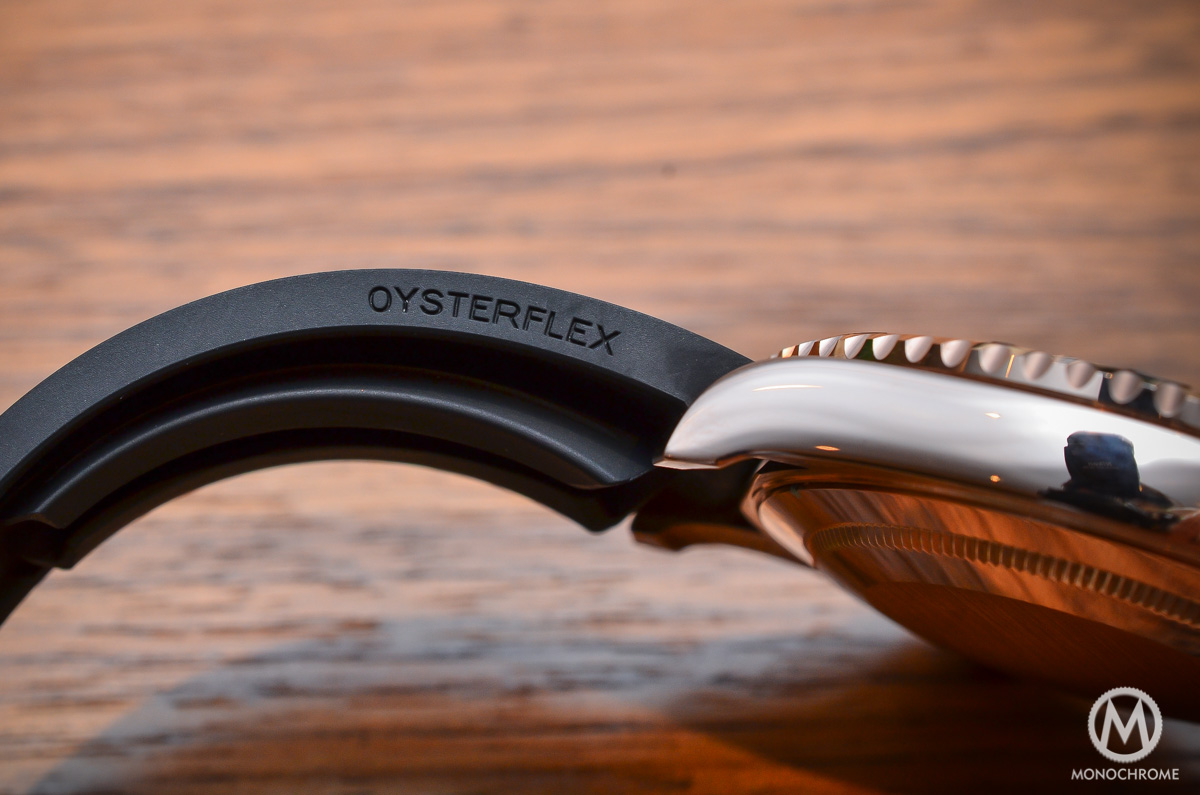
These Baselworld 2015 additions to the Rolex Yacht-Master are bringing some real good fresh air to a watch that used to be in the shadow of the Submariner. Without being an addict of gold watches, we have to admit that the contrast between the rose gold and the black accents – dial, bezel and strap – is pleasant and not too showy. This new Rolex Yacht-Master 116655 will be priced at 18.200 Euros (Ex. taxes).
9 responses
This is a fabulous watch created by Rolex and I enjoyed your report immensely!
My only grouse is though your pictures are fantastic, one cannot enlarge these pictures by clicking on them, so I shall be delighted if you can do something in this regard.
Absolutely beautiful but unfortunately out of my price range.
Never stop dreaming, Steve! I can remember saying that about watches that I now own.
How much is it? Looks amazing!
May I ask how is the rubber strap adjusted? Cutting dare I ask?
@Allan, this strap will be available in several sizes to fit every wrist. No need to cut it.
I have this watch and its very nice
Does anyone know if the oyster flex bracelet can be changed for the standard oyster bracelet? Thanks
Where can I get hold of the steel version?
Leave a Reply Cancel reply
Top stories.
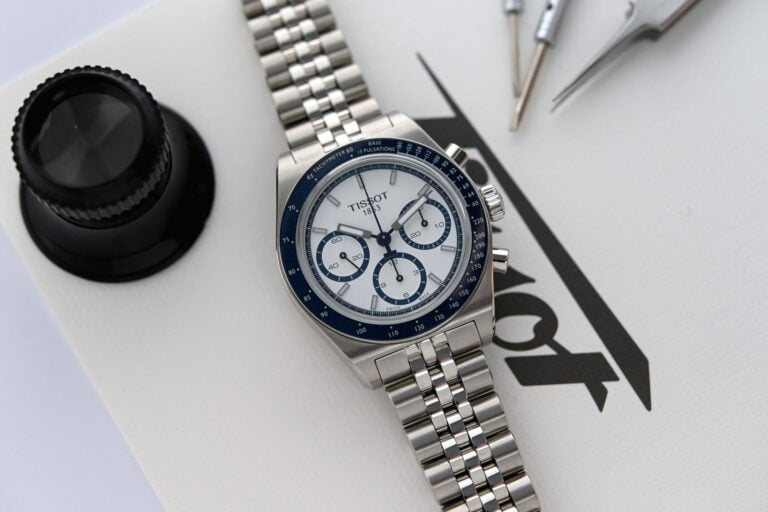
First Look Tissot Knocks It Out Of the Park Again with the PR 516 Automatic Chronograph
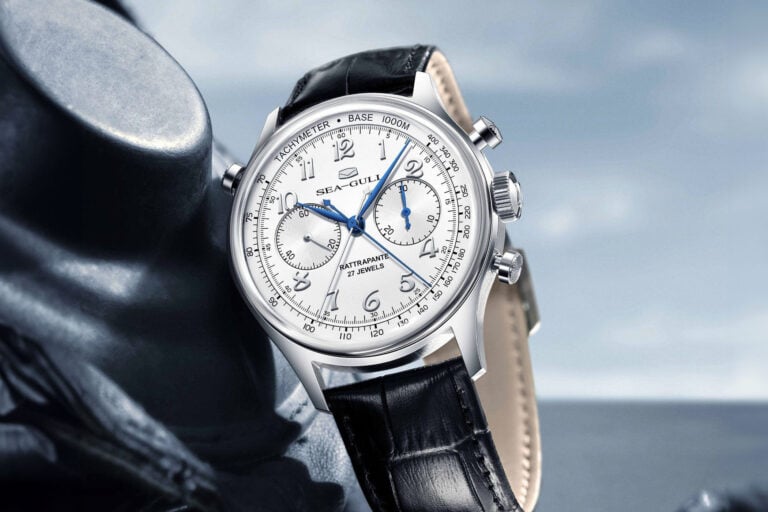
Introducing Seagull Presents a $3,500 Split-Second Chronograph, Arguably the Most Accessible Rattrapante…
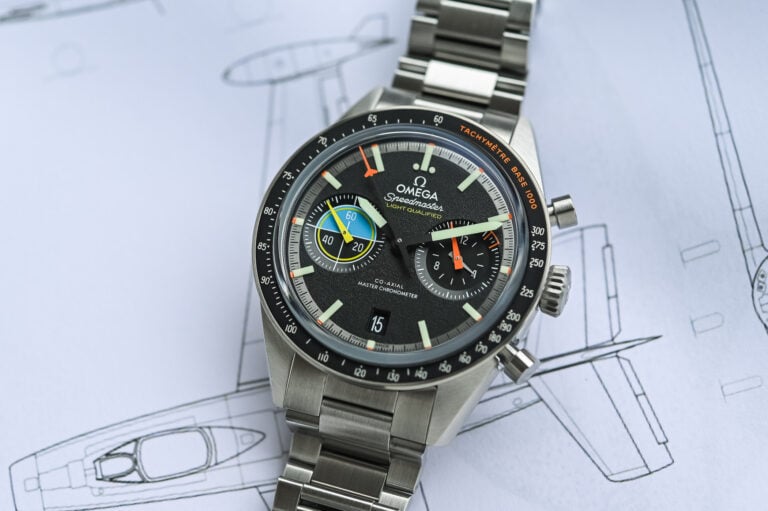
Hands-on Impressions about the Omega Speedmaster Pilot Flight Qualified
Subscribe to our newsletter, subscribe to our newsletter.

IMAGES
COMMENTS
An elegant watch with a sporty character, it was the first to be paired with an Oysterflex bracelet in 2015. In 2023, after testing under real-life conditions by acclaimed helmsman Sir Ben Ainslie, Rolex launched a new version of the Yacht-Master 42.
Rolex Yacht-Master 40 YEAR 2015 - FULL SET Used ( Very good ) | Year of production 2015 | Original box | Original papers
The Oysterflex bracelet was first introduced in 2015 on the Yacht-Master 37 and Yacht-Master 40 in 18 kt Everose gold. Its innovative design meets the specific requirements of sports watches. Developed by Rolex and patented, it combines the robustness and reliability of a metal bracelet with the flexibility, comfort and aesthetics of an ...
The thrilling world of yacht racing finds expression in the Yacht-Master II, a chronograph intended to mark time on the high seas. From the start signal to the last bend in the course, this watch keeps perfect time as it sails along the world’s most impressive coastlines.
The iconic, three-link bracelet Oyster bracelet is a Rolex staple, and it is featured across nearly the brand’s entire collection — from the Datejust to the Daytona to the Yacht-Master. In 2015, Rolex also introduced the now-famous Oysterflex bracelet on the then-new Everose gold Yacht-Master.
Built for yachting, the Rolex Yacht-Master II is the most prominent mechanical timekeeper featuring a regatta chronograph. Its proprietary Ring Command System allows the bezel to work directly with the movement to set a countdown timer while on the water.
Oct 29, 2024 · Read on to discover more about the Rolex Yacht-Master (in all its various versions) and what makes the model unique among its Oyster Perpetual brethren. Rolex Cosmograph Yacht-Master, circa 1967 (photo: Rolex Magazine.com)
Discover the Rolex Yacht-Master 42 42 mm watch in RLX titanium with a Intense black at Ben Bridge, an Official Rolex Jeweler authorized to sell and maintain Rolex watches.
In 2015, a new Yachtmaster with many surprises up its sleeve made its grand entrance. The Yacht-Master reference 116655 brought with it several firsts, not just for the Yacht-Master range, but for Rolex itself. It was the first Rolex for sale to feature the innovative Oysterflex bracelet, the brand’s take on the rubber strap.
Mar 21, 2015 · These Baselworld 2015 additions to the Rolex Yacht-Master are bringing some real good fresh air to a watch that used to be in the shadow of the Submariner. Without being an addict of gold watches, we have to admit that the contrast between the rose gold and the black accents – dial, bezel and strap – is pleasant and not too showy.